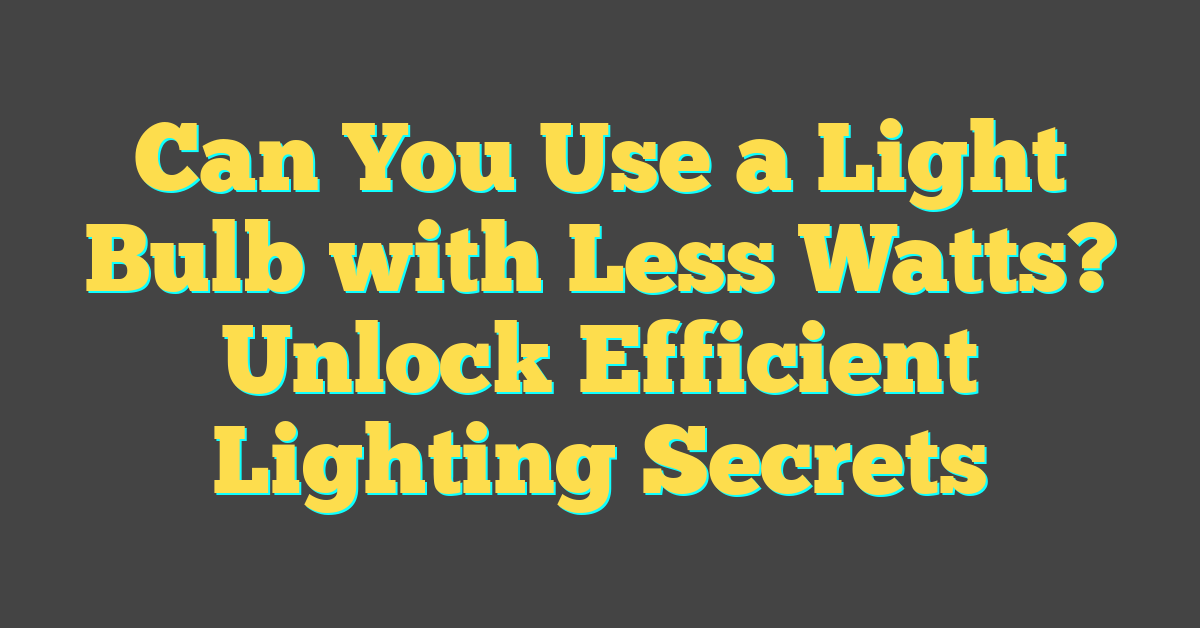When you encounter a light bulb that seems too large for your socket, it can be an unexpected and puzzling issue. It’s crucial to understand that light bulbs come in various shapes and sizes and are designed for specific sockets and fixtures. If a bulb doesn’t fit, it may be because it’s not the correct type for the socket you’re trying to use it in. This mismatch can be due to differences in bulb base size or the shape of the bulb itself.


Before installing a light bulb, always check the maximum wattage rating of your lamp or fixture to ensure compatibility. This is important because using a bulb that exceeds the fixture’s wattage rating can pose a safety risk. LED bulbs, which often have a lower wattage for the same light output compared to traditional bulbs, might seem like they can circumvent this issue, but it’s not just about wattage. The physical fit of the bulb in the socket, as well as the electrical requirements, need to be taken into consideration to ensure safe and proper function.
Key Takeaways
- Light bulbs have specific sizes and shapes for corresponding sockets.
- Always compare bulb wattage to the fixture’s maximum rating for safety.
- Ensure the physical and electrical compatibility of the light bulb and socket.
Understanding Light Bulb Basics
https://www.youtube.com/watch?v=9208FkLXQnA&embed=true
When looking to replace or fit a light bulb into a socket, you need to consider the compatibility and base size to ensure it fits correctly and functions safely.
Light Bulb and Socket Compatibility
Your light fixture requires a light bulb with a matching base to secure it properly. For instance, if your lamp has an E26 socket—the standard size for most incandescent, CFL, halogen, and LED lights in North America—you’ll need a bulb with an E26 base to match. Incompatibility between the bulb base and socket can lead to electrical issues, poor performance, or damage to both the bulb and the fixture.
Different Bulb Bases and Their Sizes
Light bulbs come in various base types, which are designated with E for Edison followed by a number that indicates the diameter of the base in millimeters. Here’s a quick guide to common bulb bases and sizes:
- E26: Often referred to as the standard or medium base, it’s 26mm in diameter and commonly found in most household lighting fixtures.
- E12: Known as the candelabra base, it’s a mere 12mm across and is often seen in decorative lighting.
- GU10: This base features a twist-and-lock mechanism, mostly used in track lighting or recessed fixtures.
- Intermediate: Slightly larger than a candelabra, this base type is not as common and is used for certain types of specialty lights.
- Mogul: A much larger base size typically used in high-wattage lighting applications such as streetlights.
Remember, always match the base size of your bulb with the corresponding socket to ensure a proper fit and to avoid the frustration of purchasing a bulb that’s too big for the socket.
Assessing Socket and Bulb Size
https://www.youtube.com/watch?v=2mprlgVseg4&embed=true
Before attempting to find a replacement bulb, it’s crucial to understand the specific measurements of your light bulb and socket. This ensures compatibility and prevents the annoyance of purchasing the wrong size.
How to Measure Your Light Bulb
To accurately measure your light bulb’s size, use a ruler or a tape measure to determine the diameter of the bulb’s base. When measuring, extend the ruler across the widest point of the bulb, making note of the size in millimeters. Standard household bulbs typically come in sizes like A19 or A15, where the number represents the diameter of the bulb in eighths of an inch. For instance, an A19 has a diameter of 19 eighths of an inch, which converts to approximately 60mm.
Identifying Your Socket Size
Identifying the socket size can be approached by measuring the diameter where the bulb screws into the socket. Turn off power to the socket for safety, then use your ruler or tape measure to size the opening, ensuring you have the measurement in millimeters for precision. Light bulb sockets come in many sizes, with E26/E27 being common in North America and B22 sockets frequently found in other regions. If the socket provides space for a bulb with a larger width or height, a reflector bulb might be necessary to achieve a proper fit. The physical size and design of the socket will correspond to these standard sizes, guiding your purchase of the correct bulb.
Knowing these measurements will avoid the inconvenience of incompatible bulb and socket pairings, saving you time and effort.
Electrical Considerations for Light Bulbs
https://www.youtube.com/watch?v=5aw1FQdYF3I&embed=true
When selecting a light bulb for your socket, it’s essential to understand the power requirements and electrical specifications. This ensures both safety and functionality in your home lighting system.
Wattage and Power Requirements
« Most Efficient Light Bulbs for Home: Top Picks for Energy-Saving Illumination
Light Bulbs Warm vs Soft: Choosing the Perfect Glow for Your Space »
Your light fixtures are designed to handle a specific maximum wattage, and this rating is crucial to consider. Using a bulb that exceeds the max wattage of a fixture can lead to overheating and, potentially, a fire hazard. For instance, installing a bulb with higher power than recommended can cause damage to the socket and the wiring of the fixture. Always check the fixture’s rating, typically labeled on or near the socket, and choose a bulb that matches or is lower than that rating.
Understanding Voltage and Current
Voltage and current are the backbones of electricity supplied to your light fixtures. Most residential lighting will typically support 120 volts in North America or 230 volts in many other parts of the world. It’s vital to ensure the bulb you select is rated for your system’s voltage to prevent underperformance or damage. Moreover, current, measured in amperes, combined with voltage dictates the wattage of the bulb. A mismatch could result in insufficient lighting or, worse, overheating. A safe practice is to consult the specific requirements labeled on the fixture to avoid any electrical mishaps.
Safety Concerns When Using Light Bulbs

When dealing with light bulbs, you need to be mindful of safety concerns to prevent dangerous situations such as overheating and potential fire hazards. Proper bulb size, well-maintained insulation, and correct wiring are critical to ensure your light fixture operates safely.
Avoiding Overheating and Fire Hazards
Heat buildup in a light fixture can lead to overheating and, in worst cases, a fire hazard. To stay safe, you should:
- Check that you’re using the correct bulb wattage for your light fixture.
- Ensure there’s ample space around the bulb to allow for proper air circulation.
- Avoid using bulbs that are too large for the socket, as they may cause the fixture to overheat.
Ensuring Proper Insulation and Wiring
Insulation and wiring are the unsung heroes in the safety of your light fixtures. Here’s how you can ensure they’re up to the task:
- Inspect wiring regularly for signs of wear, especially if you live in an older home.
- Ensure all wires are properly insulated to prevent a short circuit.
Remember that the tiny metal tab at the bottom of your socket should be raised slightly to make contact with the bulb and should not be corroded. If your light bulb is too big for the socket, the tab may not connect properly, which can lead to arcing and a potential fire hazard. Be sure to use properly fitted bulbs for your safety and the longevity of your fixtures.
Compatibility Issues and Solutions
https://www.youtube.com/watch?v=1us5m4dEV68&embed=true
When your light bulb is too big for the socket, you’re facing a compatibility issue. This can prevent the bulb from working properly and may even pose a safety risk. Identifying a good fit is crucial, and sometimes an adapter or a new socket may be required to ensure proper functionality and safety.
Using Adapters and Converters
If you find that your replacement bulb doesn’t fit in the socket, using an adapter might solve the problem. An adapter allows you to match your bulb’s base with the socket. There are various types of adapters available, like pin-to-socket or screw-to-bayonet. Before purchasing adapters, it’s a good idea to use a non-contact voltage tester to ensure the socket’s power is off to avoid the risk of electric shock.
- Check the bulb base type (e.g., E26, GU10).
- Find an appropriate adapter that matches the socket.
- Test the socket with a non-contact voltage tester.
- Fit the adapter into the socket.
- Screw your bulb into the adapter.
Remember, not all adapters are created equal, so you’ll want to find one that’s compatible with your specific bulb base and socket type.
When to Replace the Socket
Sometimes an adapter is insufficient, and you might need to consider a replacement socket. If the socket itself is incompatible, too worn, or old for the current bulb types, replacing the socket could be safer and provide a more permanent solution.
Here’s a straightforward checklist to decide if it’s time for a new socket:
- Inspect the socket: Look for damage, rust, or wear.
- Consider compatibility: Assess if modern bulbs will fit.
- Safety first: Ask if the current socket meets safety standards.
If you’re unsure, consult with a professional electrician to discuss the best course of action. Safety should always be your top priority when dealing with electrical fixtures.
Installation and Replacement Techniques
https://www.youtube.com/watch?v=WNiS3Udp_Fs&embed=true
When dealing with light bulbs that are too large for a socket, the right approach involves careful installation techniques and the proper replacement of incompatible sockets. This ensures safety and functionally of your lighting fixtures.
Tools and Techniques for Light Bulb Installation
To install a light bulb correctly, you need to make sure you’ve got the right tools and follow certain techniques. Begin by switching off the power to the fixture to avoid any electrical hazards. You’ll need a pair of pliers to help you if the bulb is stuck and some gloves to protect your hands from any shards of broken glass. Always check the label on your light fixture to verify the maximum wattage it can handle and ensure any bulb you install is within that limit. For more detailed comparisons, keep a chart handy that specifies the various bulb sizes and socket types.
- Tools You May Need:
- Pliers
- Gloves
- Chart for bulb size and socket type
Steps for Replacing an Incompatible Socket
If you find that your light bulb is too big for the socket, it’s likely time to replace the socket with one that’s the right size. Start by removing the fixture cover and then unscrewing any screws holding the socket in place. Take note of how the wires are connected before gently disconnecting them with your pliers. Acquire a new socket that matches the manufacturer specifications for your light fixture. Secure the new socket in place, reattach the wires as they were originally, and fix the socket with the provided screws. If any part of this process seems daunting, don’t hesitate to contact professional electricians for help.
- Replacement Steps:
- Turn off the power supply.
- Remove fixture cover and unscrew the old socket.
- Disconnect the wires with care.
- Match the new socket to your manufacturer’s specifications.
- Attach the new socket and rewire carefully.
- Screw the new socket into place.
- Restore the power and test the installation.
Always remember to follow safety guidelines and consult with a professional if you’re unsure about any step in the process.
Selecting the Right Light Bulb
https://www.youtube.com/watch?v=IbWAVyAl2so&embed=true
When choosing a light bulb that fits your socket, consider not just the size but also the type of bulb in terms of efficiency and lighting needs.
Comparing LED, CFL, and Incandescent Options
LED Bulb: LED bulbs are known for their energy efficiency and long lifespan. They consume less power and can save you money on your electricity bill. For a socket that typically accommodates a 60-watt incandescent bulb, you can use an LED bulb that uses only about 8 to 12 watts.
CFL (Compact Fluorescent Lamp): CFLs are another energy-efficient option, where a CFL equivalent to a 60-watt incandescent would use about 13 to 18 watts. However, they take a little longer to reach full brightness compared to LEDs.
Incandescent Bulb: Traditional incandescent bulbs are less energy-efficient than LED or CFL options. They produce a warm light but do so by heating a filament, which uses more energy — a 60-watt bulb really does use 60 watts of power.
Reading Labels and Manufacturer’s Specifications
It’s important to read the label for lumens and wattage ratings. A lumen represents the brightness of a bulb; the higher the lumen, the brighter the bulb. Always check the manufacturer’s specifications for maximum wattage to ensure the bulb’s power is within the safe limit for your socket.
Don’t forget to look at the bulb’s energy efficiency rating as well. The packaging often provides this information, helping you understand the bulb’s long-term cost and environmental impact.
Practical Applications for Different Bulb Sizes

When choosing light bulbs, it’s crucial to select the right size for your specific fixture to ensure both functionality and aesthetic appeal. Here’s how to match bulb sizes to common fixtures.
Light Bulbs for Recessed Lighting and Fixtures
For recessed lighting, typically found in your kitchen or living room, you’ll often use bulbs specifically designed to fit within the cavity of the ceiling. These fixtures usually require bulbs with a narrower base, such as R or BR types, which allow the bulb to sit flush with the fixture for a clean look.
- Examples:
- Recessed can lights: BR30
- Small accent lights: MR16
Bulbs for Specialty and Decorative Lighting
For decorative lighting, such as pendant lights and wall sconces, bulb size can influence both the light’s performance and the mood of the space. Decorative bulbs, like globe (G) shapes, provide an elegant touch and are often seen in fixtures over dining areas or in the living room.
- Examples:
- Pendant lights: G40 for a grand statement
- Wall sconces: G16.5 for a subtle ambiance
Remember that light bulbs are not one-size-fits-all. Your refrigerator, for example, needs a smaller bulb like an A15 or a specialized appliance bulb, which is built to withstand colder temperatures and vibrations. Always check your light fixture for the maximum allowable bulb size and wattage to prevent safety hazards and to ensure proper fitting.
Understanding Electrical Components of Fixtures
https://www.youtube.com/watch?v=EVOwTXHNX7E&embed=true
When you’re dealing with lighting fixtures, it’s essential to know how the internal components work together to provide you with safe and efficient lighting. In particular, with certain types of lamps like fluorescents and LEDs, components like ballasts and starters play a key role in their operation.
Ballasts and Starters in Lighting Systems
Ballasts are crucial in regulating the current to fluorescent lamps and LED tubes to ensure they provide a steady light output without damaging the lamp. When you switch on the light, ballasts provide a quick jolt of voltage to start the lamps and then maintain a lower voltage during operation.
In fluorescent systems, you’ll often find a starter, which works with the ballast to ignite the lamp. The starter is responsible for initial light-up—once the light is on, the starter’s job is done, and the ballast takes over to regulate the current. If you’re replacing fluorescent tubes with LED options, you may need a different type of ballast or possibly no ballast at all, as some LED tubes are designed to work without them.
Remember, compatibility between ballasts, starters, and lamps ensures your lighting system works optimally and safely. Always consult the specifications when you’re considering updating or changing bulbs to be sure that your components are matched properly.
DIY Tips for Light Bulb Replacement
https://www.youtube.com/watch?v=6enIXw2YyJA&embed=true
When you encounter a light bulb that seems too big for your socket, it’s important to identify the socket type and the bulb’s base to ensure they are compatible.
Troubleshooting Common Lighting Issues
First, identify the socket type. Common types include SES (Small Edison Screw), E14, and pin sockets. Knowing your fixture’s specific socket is crucial for picking the right bulb.
- SES (Small Edison Screw): If you have an SES socket, but your bulb doesn’t fit, you might be using a standard-sized Edison bulb instead of the “small” variety.
- E14: These are also called European Edison Screws and are 14mm in diameter. Ensure your bulb is not an E27, which is larger and won’t fit your E14 socket.
- Pin Socket: Double-check the number and arrangement of pins, as it’s easy to confuse similar types.
Next, safely remove the bulb and inspect the lamp holders. Carefully unscrew the bulb counterclockwise. If the bulb is stuck, make sure you’ve turned the circuit breaker off before attempting to wiggle the bulb free with a cloth for a better grip.
Check the socket type – an Edison screw requires a matching Edison bulb (E14, SES, etc.). Incorrect bulb base types won’t fit into the socket, which can lead to frustration. For example, if you have a lamp holder meant for an SES bulb, do not attempt to force in a larger screw bulb as it may damage the socket.
Lastly, always reset the circuit breaker after changing bulbs to ensure your safety and the proper functioning of the new bulb. If issues persist, consult an electrician to check for deeper electrical problems.




